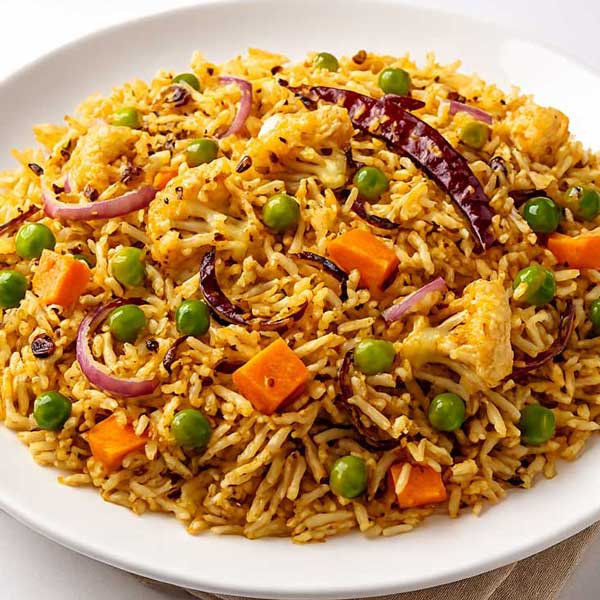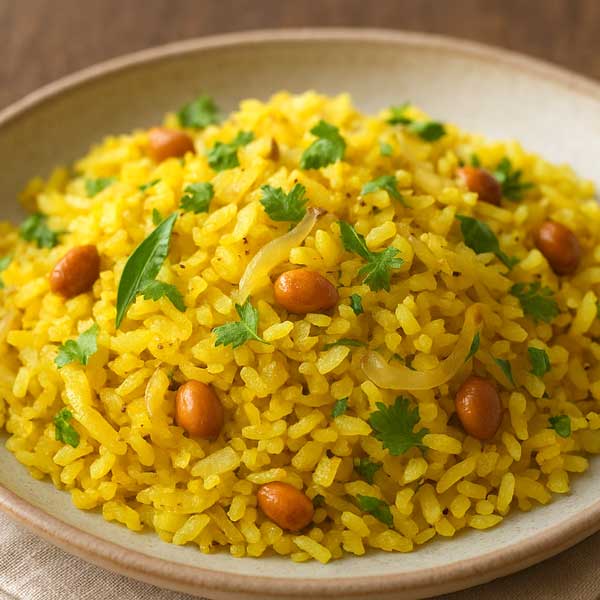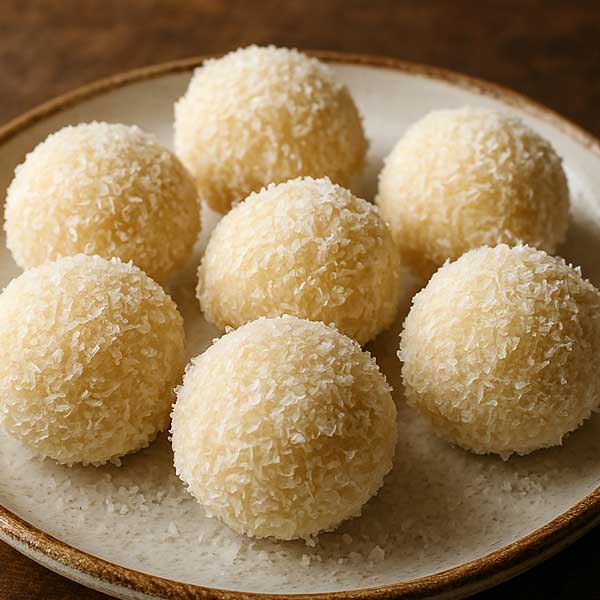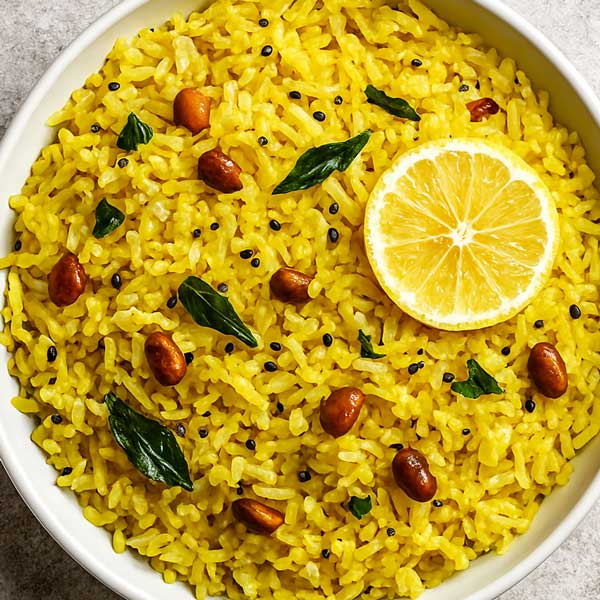Poha Recipe | Easy Flattened Rice Dish
Poha is a light, healthy, and easy Indian breakfast recipe made with flattened rice, vegetables, and mild spices. If you’re wondering how to make poha at home, it’s one of the easiest recipes to prepare, perfect for beginners.
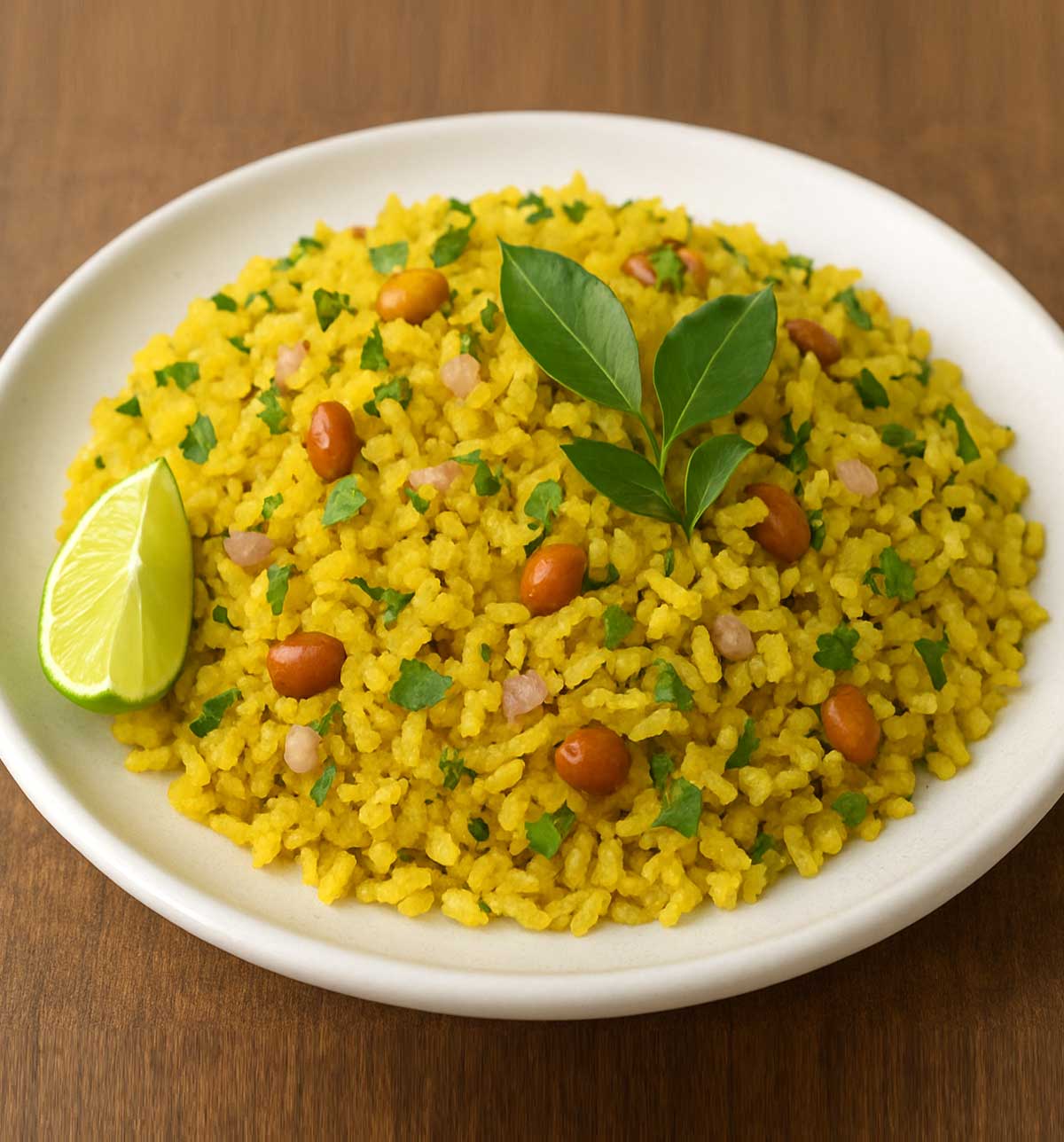
Poha is very popular in Maharashtra and Madhya Pradesh but is enjoyed all over India. In Maharashtra, it is known as Kanda Poha when made with onions and Batata Poha when made with potatoes. It is a staple breakfast dish in Marathi households and is often served with tea. You can also learn how to make poha without onion or garlic if you prefer a simpler version. The best part of cooking poha is that it’s a super easy snack recipe to make, takes only 15–20 minutes to prepare and is ideal for a filling breakfast or evening snack.
Quick Cooking Tips
- Use thick poha: Always go for thick flattened rice. Thin poha turns mushy very quickly when rinsed, thick poha holds its shape after soaking and gives best results.
- Enhance nutrition: You can add peas, carrots, or capsicum to make it healthier. It turns this light flattened rice dish into a more balanced and filling meal.
- Avoid overmixing: Gently mix the poha so it doesn’t break and become mushy. Overmixing can break the rice grains and make the poha mushy. Use a light hand for a fluffy texture.
Ingredients and Substitutes
- Poha (thick flattened rice): This is the main ingredient that gives the dish its light, fluffy texture. I use thick poha because it holds its shape well and gives a fluffy texture. If thick poha isn’t available, medium poha works too just be careful not to soak it for long. Thin poha tends to get soggy, so rinse it lightly and use immediately.
- Turmeric powder: Turmeric gives poha its classic yellow color and a warm, earthy flavor. If you don’t have it, you can skip it, but the poha will stay white and miss that traditional look.
- Salt (adjust to taste): Regular salt brings out all the other flavors. You can use black salt or low-sodium salt as a substitute, depending on your dietary needs or taste preference.
- Sugar (optional): A small pinch of sugar balances the flavors and gives a gentle sweetness. If you like a hint of sweet, you can also use jaggery powder. Or skip it if you prefer your poha completely savory.
- Lemon Juice: I squeeze in fresh lemon juice at the end for a tangy, refreshing finish. Lime juice works just as well. If you don’t have fresh citrus, a small pinch of amchur (dry mango powder) can give a similar tartness.
- Cooking Oil: Any neutral oil like sunflower, peanut, or vegetable oil is great for tempering. For a richer flavor, I sometimes use ghee instead.
- Mustard seeds: Mustard seeds give that signature South Indian aroma when they pop in hot oil. If you’re out of mustard seeds, nigella seeds (kalonji) can add a different flavor.
- Cumin seeds: Cumin seeds add an earthy, toasty flavor to the poha. If you don’t have cumin, caraway seeds (ajwain) can be used for a more herbal twist or simply skip them.
- Curry leaves: Curry leaves give an authentic aroma and flavor. If you don’t have fresh ones, you can skip them, or add a small bay leaf for a mild fragrance though it’s not quite the same.
- Green chili: I usually add one green chili for heat. For extra flavor, you can also add a pinch of red chili powder or black pepper., or even skip it for a milder version especially if serving kids.
- Onions: Onion adds a hint of sweetness and makes the poha more flavorful. Shallots or spring onions work well too. For a no-onion version (e.g., during fasting), you can leave it out entirely.
- Peanuts: Peanuts add crunch and nutty taste in poha. If you’re allergic or don’t have any, try roasted cashews, roasted chana dal, or sunflower seeds for that crunchy element.
- Coriander leaves: Fresh coriander adds color and freshness. If it’s not available, mint leaves can be a refreshing alternative, or just skip the garnish.
- Sev (optional): Sev gives a fun, crispy topping to finish the dish. You can also use boondi or crushed papdi, or simply skip the garnish for a lighter version.
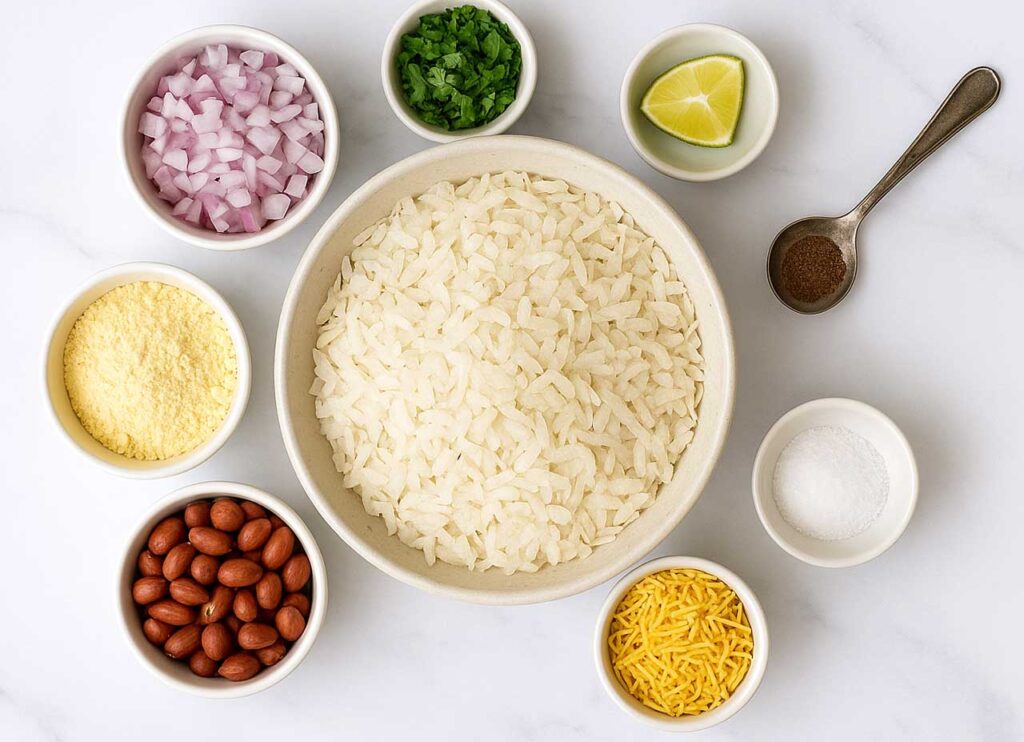
How to Make Poha (Step-by-Step)
- Rinse Poha Properly: Place poha in a sieve, wash lightly under running water, and drain completely for a few minutes.
- Roast Peanuts for Crunch: Heat oil, roast raw peanuts until golden, then remove and keep aside.
- Prepare Tempering: Sauté mustard seeds, cumin, curry leaves, and green chilies in oil, then cook onions until translucent.
- Cook Poha with Spices: Combine turmeric, red chili powder, roasted peanuts, and salt, then gently fold in poha on low flame until evenly coated.
- Add Finishing Touches: Turn off heat, drizzle lemon juice, toss with fresh coriander, sprinkle sev if desired, and serve hot with tea or chutney.
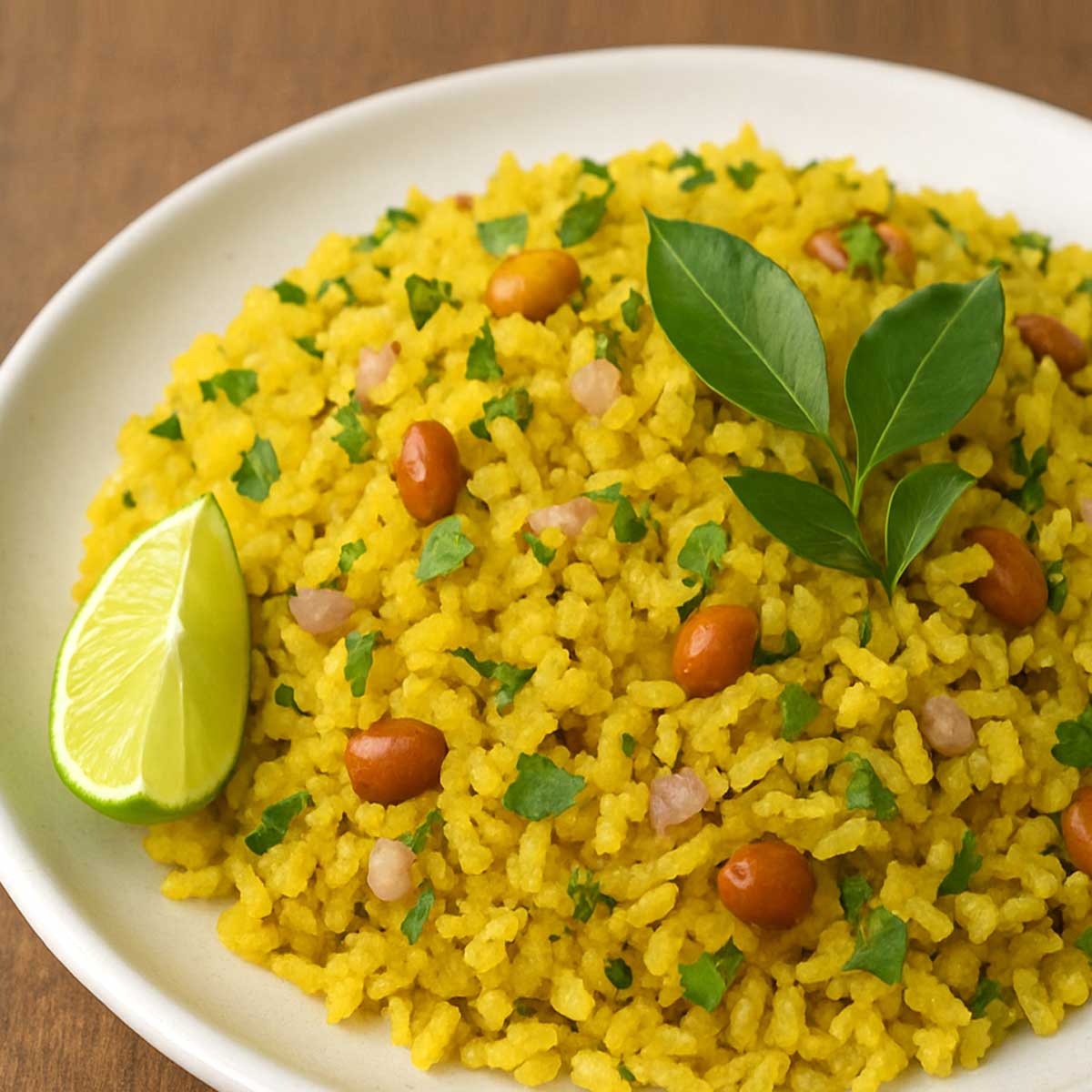
How to Make Soft and Fluffy Poha for Breakfast
When making soft and fluffy poha for breakfast, start by choosing flattened rice that doesn’t break easily and rinse it gently under running water to prevent sogginess. Use a fine-mesh sieve or colander to drain excess water completely. Always cook poha in a non-stick pan or heavy-bottomed pan for even cooking. Heat oil gradually rather than adding it to a very hot pan, and roast raw peanuts for poha separately to retain crunchiness. While sautéing spices and onions, maintain medium to low heat for cooking poha, so the flavors develop without burning. Adding turmeric and chili powder after the onions turn soft ensures an even coating and bright color.
Tips, Dos and Don’ts for Perfect Poha
Avoid over-soaking poha or stirring it vigorously, as this can make the flattened rice mushy and sticky. Do not skip tempering with mustard seeds, cumin, curry leaves, and green chilies, which is essential for authentic poha flavor. Use fresh coriander for garnish, and sprinkle sev just before serving to maintain crispiness. Serve immediately with fresh lemon juice for tangy poha and pair with tea or chutney for a quick and healthy Indian breakfast recipe that’s perfect for mornings.
Serving Suggestions for Poha
- Serve Poha with a Wedge of Lemon : Always serve poha warm, with a fresh wedge of lemon on the side. A final squeeze of lemon before eating brings out all the flavors.
- Top with Crispy Sev or Bhujia: To make poha extra crunchy and a street-style feel, sprinkle some amounts of sev or bhujia just before serving.
- Serve Poha with Masala Chai or Filter Coffee : Poha makes a perfect breakfast or evening snack when paired with a hot cup of Indian masala tea or strong South Indian filter coffee.
- Add a Side of Curd or Raita: If you want a light lunch, pair poha with a small bowl of plain curd, or raita. It balances the heat and adds creaminess.
- Garnish with Pomegranate Seeds : Top poha with chopped coriander for freshness and a few pomegranate pearls for a pop of color and sweetness. You can add a side of spicy mango pickle or green chutney for an extra zing.
Frequently asked questions
Poha can turn mushy if it’s soaked for too long or if you’re using thin rice flakes instead of thick ones, as both make it soggy.
Yes, poha is naturally gluten-free dish because it’s made from flattened rice and doesn’t contain wheat or other gluten grains. Just make sure you don’t add any ingredient with gluten while making it.
To soften flattened rice, rinse it gently under running water for a few seconds and let it sit for 5–10 minutes to absorb water.
Yes, thick flattened rice is better for cooking dishes because it holds its shape for dishes like Kanda or Batata Poha, while thin poha is used in snacks like chivda and doesn’t require rinsing in water.
Yes, poha is a healthy and light breakfast option as it is made by minimally processing paddy. It’s low in calories, easy to digest, and can be made more nutritious by adding vegetables, nuts, and spices.
Poha Variations You Can Try
- Kanda Poha: Skip potatoes and use only onions.
- Batata Poha: Classic version with potatoes.
- Mixed Vegetable Poha: Add peas, carrots, and capsicum for a healthier version.
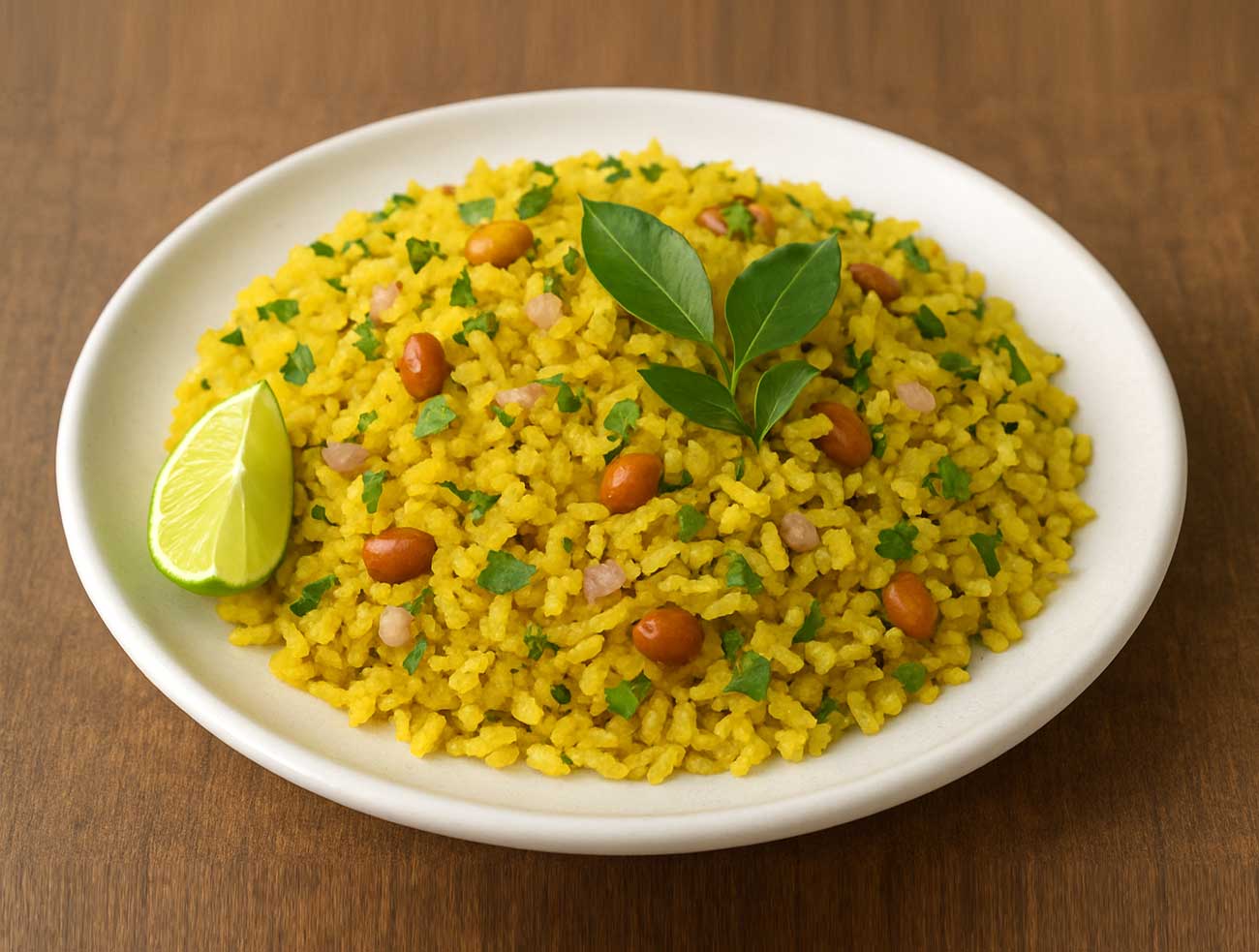
Recipe Card
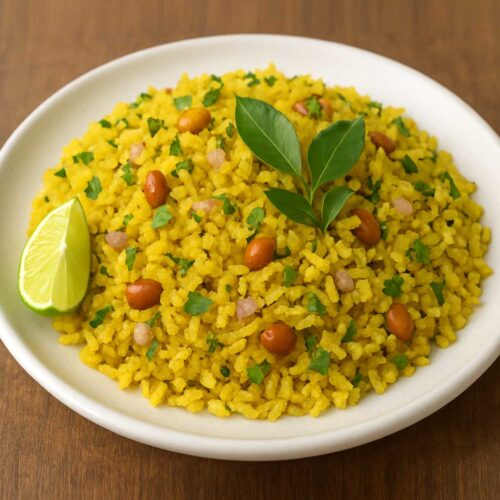
Poha Recipe (Flattened Rice Dish)
Equipment
- 1 Colander or Sieve
- 1 Kadhai / Deep Pan
- 1 Spatula or Wooden Spoon
- 1 Knife and chopping board
- 1 Serving Plate or Bowl
Ingredients
- 1 cup Poha thick flattened rice
- ½ tsp Turmeric powder
- ½ tsp Salt adjust to taste
- ¼ tsp Sugar optional
- ½ cup Lemon Juice
- 1 tbsp Cooking oil
- ½ tsp Mustard seeds
- ½ tsp Cumin seeds
- 10 Curry leaves
- 1 Green chili finely chopped
- 1 small Onion finely chopped
- 1 small Potato diced into small cubes
- 1 tbsp Raw peanuts
- ¼ tsp Red chili powder optional
- ¼ cup Green peas
- ¼ cup Carrots finely chopped
- 2 tbsp Coriander leaves chopped
- Sev optional
Instructions
- Place the poha in a sieve or colander over a bowl and rinse gently under running water for a few seconds without soaking. Let the excess water drain completely and set aside for a few minutes.
- Heat oil in a pan, add raw peanuts, and roast them until golden. Remove and set aside.
- In the same pan, to prepare the tempering. Heat oil, add mustard seeds, cumin seeds, curry leaves, and chopped green chilies. Sauté until fragrant, then add chopped onions and cook until soft and translucent.
- Add turmeric powder, red chili powder, roasted peanuts, and salt. Stir well, then gently add the rinsed poha. Mix everything on low flame until evenly coated.
- Turn off the flame, squeeze some lemon juice over the poha, and give it a final toss.
- Garnish with freshly chopped coriander leaves and, if desired, sprinkle sev for extra crunch. Serve hot with a cup of tea or chutney.
Notes
- Use thick poha for best texture.
- Do not overmix to avoid mushiness.
- Add your favorite vegetables for extra nutrition.

